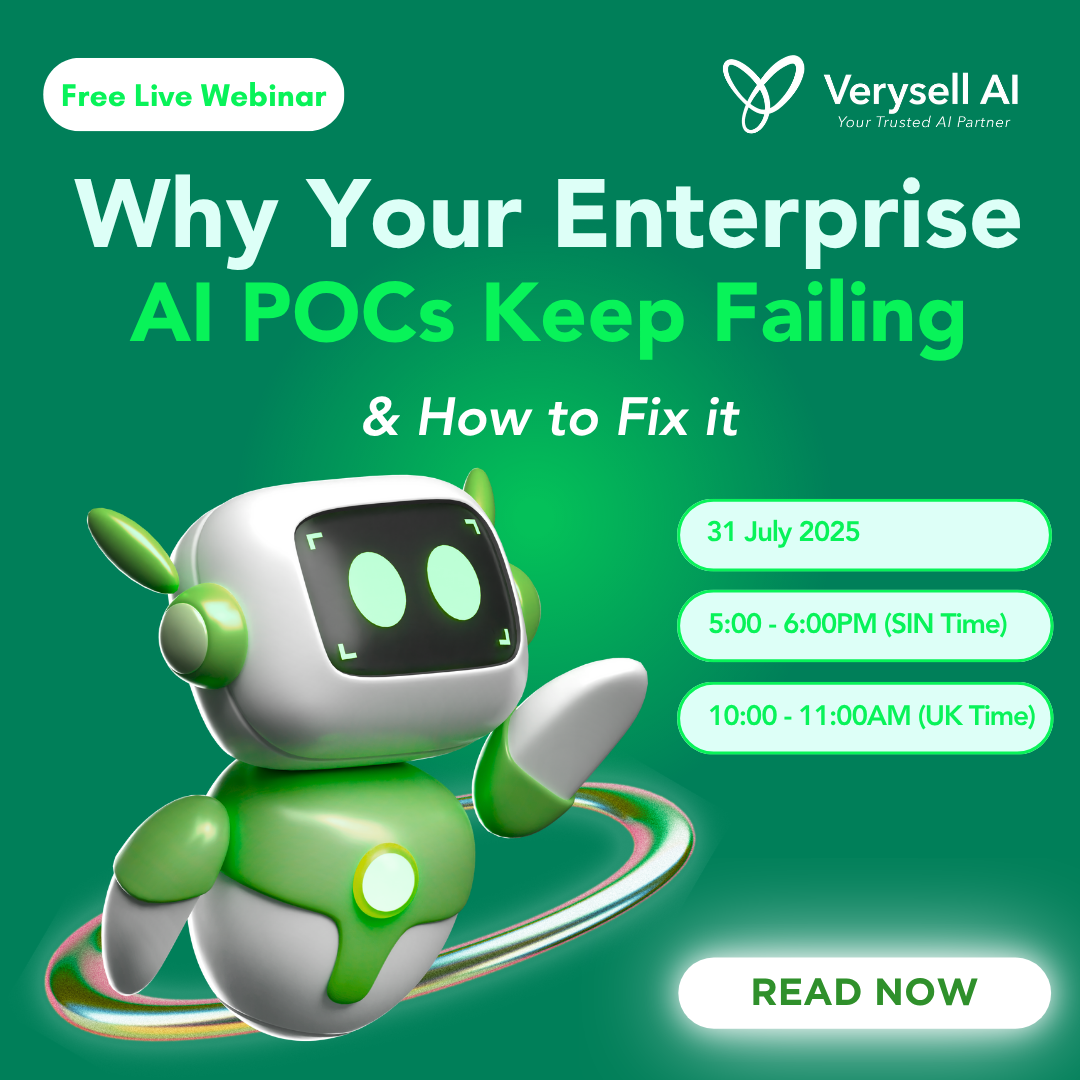AI POCs (Proof of Concepts) have become a critical component of enterprise AI adoption. However, despite their importance, a staggering 80% of AI POCs fail to meet their objectives (Morales, 2024), leaving businesses questioning the real value of AI implementation. As more organizations look to integrate AI solutions into their operations, understanding why these POCs fail and how to fix them, is crucial for successful adoption and long-term business transformation.
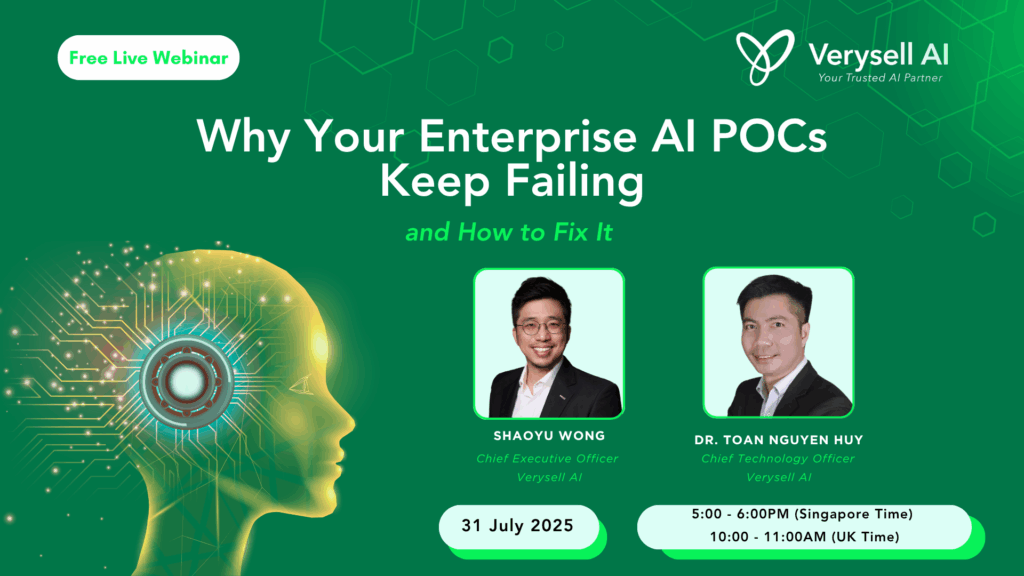
The reasons behind AI POC failures are multifaceted, ranging from misaligned business strategies to rapidly changing technologies and unresolved communication gaps between business and AI teams. In this blog, we’ll explore the root causes of AI POCs’ failures and introduce a proven solution: the 6-Layer Framework designed by Verysell AI to address these challenges. Furthermore, we’ll discuss how our 10-Week Product-ready Program can help businesses accelerate their AI adoption journey, transforming POCs into actionable, scalable solutions.
>> Click here to explore our webinar series!
1. The AI Failure Epidemic: Understanding the Root Causes
AI POCs often fall short due to a variety of factors that prevent successful implementation. Let’s take a closer look at the primary causes of failure:
1.1 Strategy-Execution Gap
One of the most critical issues enterprises face when adopting AI is the misalignment between business goals and technical execution (Gonesh et al. 2023). 68% of AI teams and business teams often fail to communicate effectively, leading to a disconnect (Gartner). Business teams are focused on tangible outcomes like ROI, revenue, and customer satisfaction, while AI teams concentrate on technical metrics like accuracy, model performance, and data quality. Without a shared understanding, AI projects can lose focus and fail to meet expectations.

1.2 The Speed Trap
According to McKinsey (2023), AI technology is evolving at an incredibly fast rate about three times faster than enterprise development cycles. By the time an AI model is approved, tested, and integrated into a business, it may already be obsolete. This rapid rate of evolution presents a significant challenge for enterprises attempting to keep pace with technological advancements. As a result, AI projects may fail to deliver value, as they are based on outdated models or technologies.

1.3 Pilot Purgatory
A significant number of organizations fall into what’s known as “Pilot Purgatory.” While companies often launch multiple AI POCs, many of these initiatives fail to scale. A study by Deloitte found that 72% of companies deploy three to five isolated POCs, but only 28% successfully scale them. The lack of clear success criteria and decision-making processes often leads to ongoing pilot projects without ever achieving tangible results.

2. The 6-Layer Framework: A Proven Solution for AI Adoption
At Verysell AI, we’ve developed the 6-Layer Framework, which is designed to address these common challenges and ensure successful AI adoption. This framework provides a structured approach to AI implementation, covering all aspects of the process from business alignment to continuous improvement.
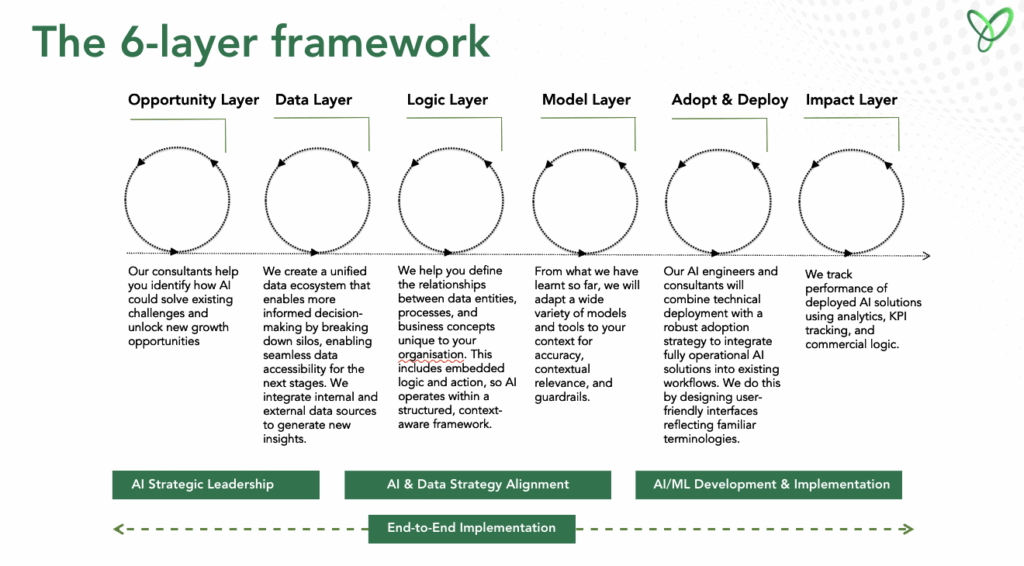
2.1 Layer 1: Opportunity
The approach aims to provide leadership in artificial intelligence and establish a scalable AI strategy that aligns with your business objectives. Key focus areas include mapping AI opportunities to business needs, developing a comprehensive AI strategy, and creating a detailed roadmap. The approach also incorporates executive and leadership workshops to foster understanding and engagement with AI initiatives.

The expected outputs of this approach include a clearly defined AI strategy that aligns with your business goals, identified AI use cases with projected return on investment, and monthly advisory sessions with AI consultants for ongoing support. Deliverables will consist of an AI Strategy Workshop to kickstart the initiative, an initiative roadmap that reflects the corporate vision, and an assessment and prioritization of AI opportunities to ensure effective implementation.
2.2 Layer 2-3-4: Data – Logic – Model
The objective is to align AI initiatives with product and data strategies to ensure seamless execution across the organization. Key focus areas include product planning, the development of an AI-driven product and technology roadmap, and assessing the feasibility of data strategies and AI models. Additionally, the exploration of generative AI and its potential impact will be a crucial aspect of this alignment.

Expected outputs from this approach include a structured AI technology roadmap and a defined AI data strategy that aligns with business objectives. To facilitate ongoing collaboration, there will be weekly alignment sessions with the Chief Product Officer (CPO) and technical teams. Deliverables will encompass weekly meetings focused on tech and product strategy, an AI product roadmap with an implementation plan, the development of an AI-driven data strategy, and an exploration of generative AI’s impact on product development.
2.3 Layer 5-6: Adopt & Deploy, Impact
The objective is to build, train, and deploy AI and machine learning models supported by scalable data architectures. This initiative focuses on several key areas, including the development and optimization of AI/ML models, data engineering, and the creation of scalable architectures. Additionally, it emphasizes the implementation of generative AI and advanced analytics to enhance overall functionality and effectiveness.
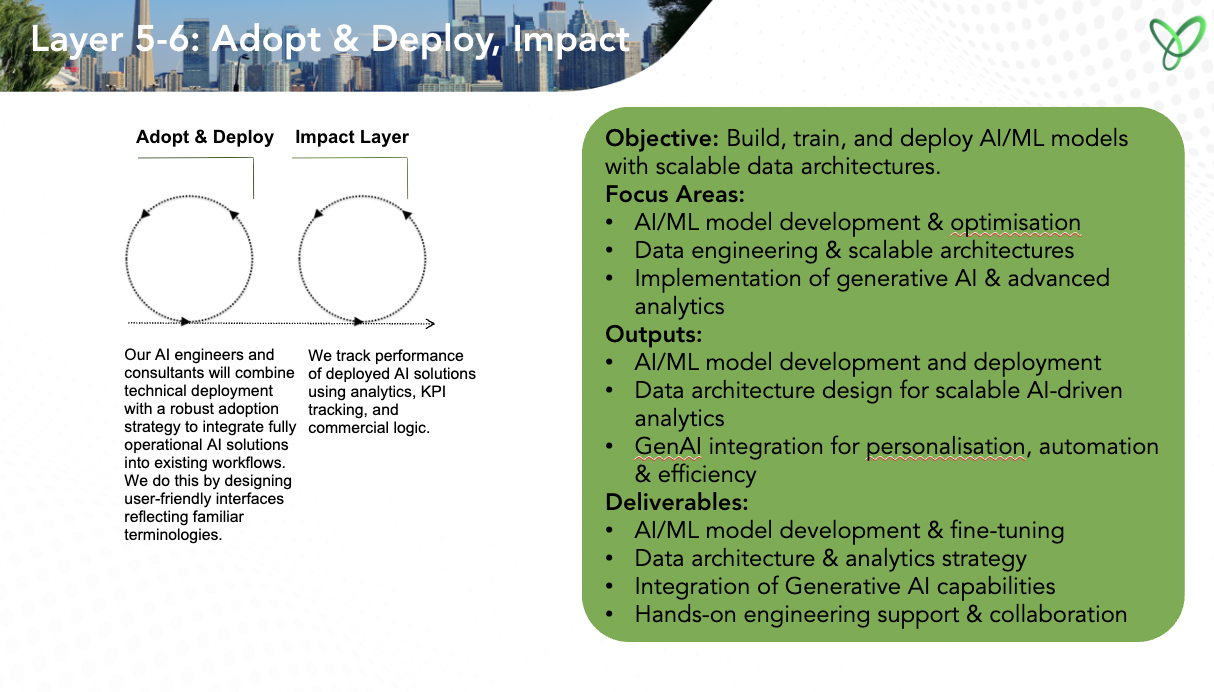
The expected outputs include the development and deployment of AI/ML models, as well as the design of data architectures that facilitate scalable AI-driven analytics. This project aims to integrate generative AI capabilities to improve personalization, automation, and operational efficiency. Deliverables will consist of refined AI/ML models, a comprehensive data architecture and analytics strategy, and hands-on engineering support and collaboration to ensure successful implementation and integration of these advanced technologies.
3. The 10-Week-Product-Ready Program: Accelerating AI Adoption
While the 6-Layer Framework provides a comprehensive approach to AI adoption, we understand that enterprises need results quickly. Traditional AI development cycles can take 18 months or more, but businesses can’t afford to wait that long in today’s fast-paced market. So, that’s why we have 10-week-product-ready program services that follow 6 layer framework, addressing each layer in the process while maintaining the speed necessary to keep up with the fast-paced world of AI. By the end of each sprint, businesses have a fully functional AI solution that delivers measurable business outcomes.
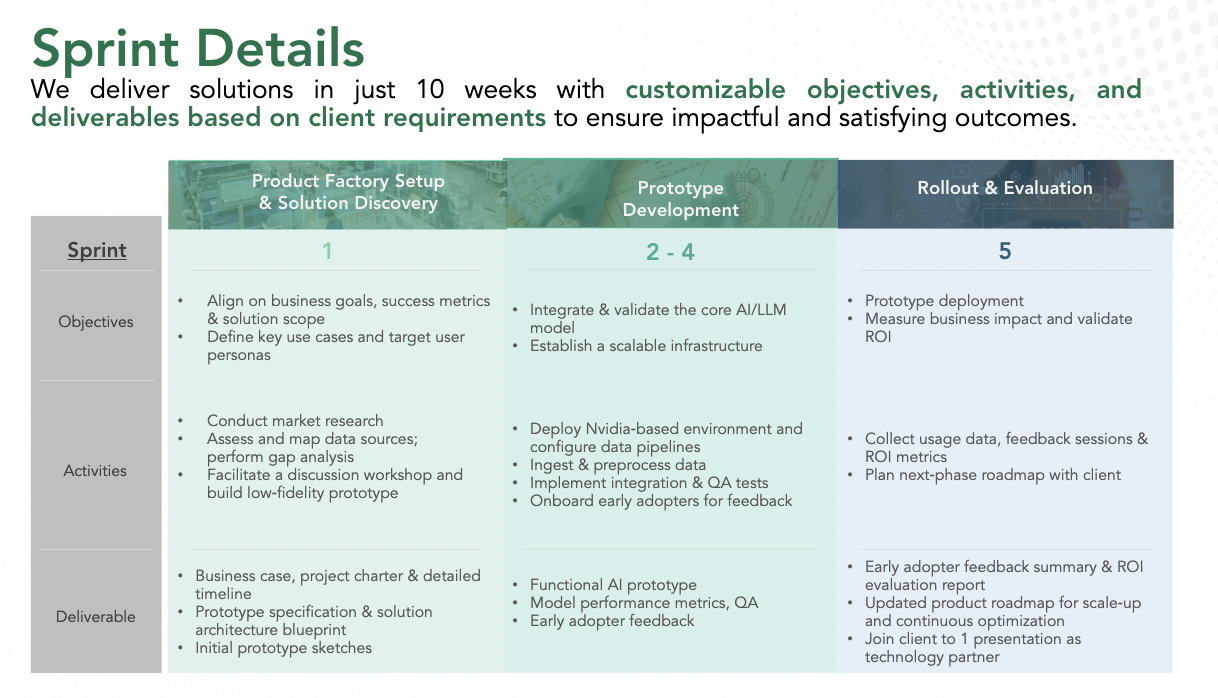
4. Proof in Practice: Real-World Success Stories
The success of the 10-Week Sprint has been proven in real-world environments. For example, in the manufacturing industry, we helped a company reduce downtime by 44% by implementing an AI-driven NLP+IoT agent in just 10 weeks. In the BFSI sector, we implemented a CV+NLP ensemble solution that processed data 68% faster than traditional methods. These success stories demonstrate the power of the 6-Layer Framework and 10-Week Sprint in driving effective AI adoption.
Click here to achieve 15 use cases in each BFSI and Manufacturing industry!
4.1 BFSI Transformation
In the Banking, Financial Services, and Insurance (BFSI) sector, the problem of manual fraud detection posed significant delays and inefficiencies in processing claims (Preez et al., 2025). To tackle this challenge, a combined approach utilizing a Computer Vision (CV) and Natural Language Processing (NLP) ensemble was deployed. This solution not only streamlined the fraud detection process but also enhanced its accuracy. As a result, the processing time improved dramatically, achieving a 68% faster turnaround for fraud detection tasks. This transformation not only optimized operational efficiency but also bolstered the overall security and trustworthiness of financial transactions.

4.2 Manufacturing Case
In the manufacturing sector, a significant challenge has been identified, with 29% of sales lost due to downtime (Splunk, 2024). To address this issue, an innovative solution was implemented involving the integration of a Natural Language Processing (NLP) and Internet of Things (IoT) agent, developed over a 10-week period. This advanced system enabled real-time monitoring and analysis of equipment performance, ultimately leading to a remarkable 44% reduction in downtime. By leveraging AI technologies, the manufacturing process became more efficient, resulting in improved operational performance and reduced sales losses.
5. AI POCs Don’t Have to Fail
AI POCs don’t have to be an exercise in futility. By addressing the root causes of AI POC failure and applying a structured framework like the 6-Layer Framework, businesses can dramatically increase the chances of success. The 10-Week Sprint further accelerates this process, allowing organizations to implement AI solutions faster without sacrificing quality.
If your AI POC is stuck in pilot purgatory, or you’ve been testing POCs with no real proof of value, it’s time to take a new approach. Reach out to Verysell AI today and discover how our 10-Week Sprint can help you turn your AI POCs into actionable, scalable solutions that drive real business value. Ready to take the next step in your AI journey? Book a free 30-minute discovery call with our AI team to get started on transforming your AI POCs into real-world solutions that deliver measurable results.


